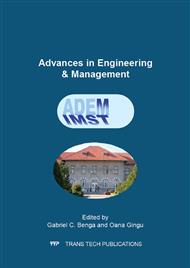[1]
http: /www. eia. gov, International Energy Statistics - EIA.
Google Scholar
[2]
G. Singh, Environmental Aspects of Coal Combustion Residues from Thermal Power Plants, in: Thermal Power Plants - Advanced Applications, M, Rasul (Eds. ), ISBN 978-953-51-1095-8, http: /www. intechopen. com/books/thermal-power-plants-advanced applications/ environmental-aspects-of-coal-combustion-residues-from-thermal-power-plants.
DOI: 10.5772/56038
Google Scholar
[3]
http: /eescopinions. eesc. europa. eu/viewdoc. aspx?doc=ces/ccmi/ccmi087/ro/ces1597-2011_ac_ro. doc, Processing and exploitation of industrial and mining waste, CCMI/087, Brussels, (2011).
Google Scholar
[4]
K. Juda-Rezler, D. Kowalczyk, Size distribution and trace elements contents of coal fly ash from pulverized boilers , Polish Journal of Environmental Studies, vol. 22, No. 1, 2013, pp.25-40, ISSN: 1230-1485, Olsztyn, Poland.
Google Scholar
[5]
BREF Large Combustion Plants, available at http: /www. anpm. ro.
Google Scholar
[6]
U. Kant, V. K. Saxena, A. Sarkar, Atul K. Varma, K. K. Mishra, Characterization of Coal ash from a Captive Power plant for Potential End uses, Proceedings of the Eurocoalash 2012 Conference, Thessaloniki, Greece, September 25-27 2012, http: / www. evipar. org.
Google Scholar
[7]
I. Petean, G. Arghir, A. Braşovan, V. Codrea, R. Flavia Câmpean, A. G. Hosu – Prack, minerals distribution in coal fly ash from Paroseni power plant, http: /stiintasiinginerie. ro/wp-content/uploads/2014/01/78-DISTRIBU%C5%A2IA-MINERALELOR-%C3%8EN-CENU%C5%9EA-DE-HUIL%C4%82. pdf.
Google Scholar
[8]
Brookhaven, 90 Plus Nanoparticle Size Analyzer, Instruction Manual.
Google Scholar
[9]
M. S. H. bin Mohd Sani, F. bt Muftah, Z. Muda, The Properties of Special Concrete Using Washed Bottom Ash (WBA) as Partial Sand Replacement, International Journal of Sustainable Construction Engineering & Technology Vol 1, No 2, December 2010, pp.65-76.
DOI: 10.1109/isbeia.2011.6088799
Google Scholar
[10]
G. Vasudevan, Performance on coal bottom ash in hot mix asphalt, International Journal of Research in Engineering and Technology, Volume: 02 Issue: 08 | Aug-2013, http: /www. ijret. org.
DOI: 10.15623/ijret.2013.0208004
Google Scholar
[11]
ISO 13320-1: 2009 Particle size analysis – Laser diffraction methods.
Google Scholar
[12]
A. Premo Black, New study finds utilizing coal ash in roads and bridges, Ash at Work Issue 1 2011, pg 8-13, http: /www. acaa-usa. org/Portals/9/Files/PDFs/Ash_at_Work_final _LR. pdf.
Google Scholar


